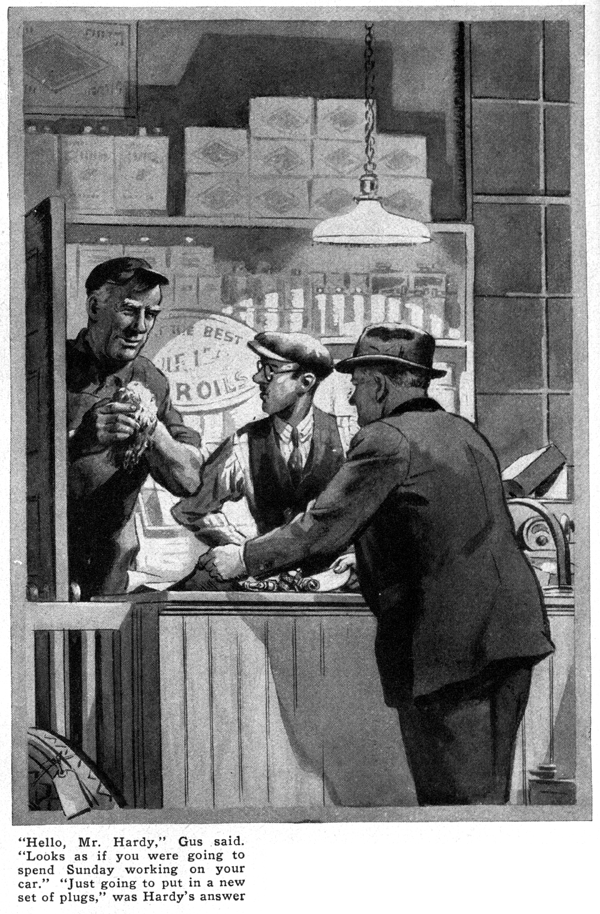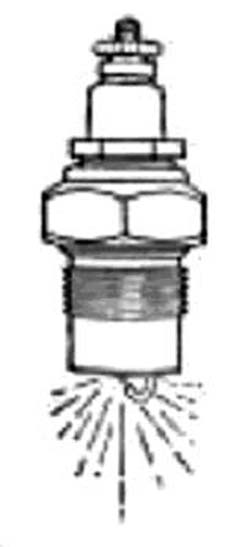April 1933
CHOOSE YOUR SPARK PLUGS TO FIT YOUR CAR
by Martin Bunn

Late one Saturday night a short man bustled into the small salesroom adjoining the Model Garage repair shop.
"Got six new spark plugs just like these?" he asked, pushing a soiled newspaper package across the counter to Joe Clark.
Gus Wilson, wiping his hands on a piece of waste, poked his gray head through the open repair shop door.
"Hello, Mr. Hardy," he called. "Looks as if you were going to spend Sunday working on your car."
"Just going to put in a new set of plugs," replied Hardy. "These look pretty bad."
Gus picked up one of the old plugs and scraped the tip of the insulator with his thumb-nail. "They're not in such good shape," he agreed. "What type of plug did you buy this time?"
"Why, the same kind I've been using, of course," replied Hardy.
"If your car's in good shape, that's O.K.," nodded Gus. "But sometimes, particularly after the car gets old, a different type may work better."
Gus reached across the counter and selected several plugs from a trim metal rack on one of the stock shelves.
"You know," he said, "manufacturers make a lot of different kinds of spark plugs now -- hot plugs, medium plugs, and cold plugs. One concern makes eight types for automobiles, each for a different temperature range."
"Some new scheme to sell more spark plugs?" said Hardy sarcastically.
"Nope it's on the level. If your motor runs cold and your plugs foul, you need a plug that runs hotter. On the other hand, if you get pre-ignition knocks and the motor overheats, a colder plug may help. Of course, if your motor's in A-1 shape you can keep on using the same type of plug that was in the car when you bought it."
"How can one plug be hotter than another?" demanded Hardy. "Is it the spark that's hotter?"
"The spark hasn't anything to do with it," Gus explained, picking up one of the new plugs from the counter. "A hot plug has a larger body inside the cylinder. Naturally, it runs hotter than a plug of the colder type. A hot plug burns off the excess oil and keeps the tips cleaner in a motor that runs cold."
Hardy examined the plugs closely.
"Of course," Gus continued, "ten thousand miles is about all you can expect to get out of any set of plugs. And you'll only get that if they're kept clean and are adjusted now and then."
"Say, that stone crusher of mine has been pounding some lately. Maybe colder plugs are what I need," Hardy said thoughtfully. "I think I'll try a set. By the way, Gus," he asked as he stuffed the six new plugs into his coat pockets. "Is there any trick about cleaning plugs?"
"None, if you're careful. After all only about four things can happen to a plug -- the insulator tip can foul with oil and soot, the points can burn or foul, the air gap can be wrong or the insulator can get damaged," Gus enumerated. "You never want to scrape the carbon off the insulator. Wash it off with gasoline. If you scrape it with a knife, nine times out of ten you'll chip the glaze on the porcelain and the insulator will leak electricity.
"A safe way to clean plugs is to use an old stiff-bristled toothbrush dipped in gasoline. To clean the points, take a small square of emery cloth doubled over so the abrasive is on the outside. That'll slip between the points easily."
"How about testing the thickness of the air gap?" asked Hardy.
"That depends on the car," replied Gus.
"The gap should be set to the specifications given for the motor. It's different for almost every make of car. If the gap's too wide, the motor will miss on long, heavy pulls at slow speed. If it's too narrow, you'll have trouble at high speed."
"Do bad plugs always show up in the way the motor runs?"
"Not always. You can have six bum plugs in your car and still think that it's running O.K. But you'll find a big difference in the amount of gas you have to buy."
"That's right," interrupted Joe. "Henry Dunham put a new set of plugs in his bus last month and claims he's getting two or three miles more out of every gallon of gas."
"I don't see how you can tell whether a spark plug is any good," put in Hardy. "They all look the same to me."
"You can find out for sure by taking them to a good service station," said Gus. "Or you can check them for short circuits yourself if you want to. Run your motor and then short-circuit each plug in turn with a screwdriver or a hammerhead. If cutting out a plug doesn't make the motor run slower, you can bet there's something wrong with that plug. When a good plug is shorted, the motor will slow down."
"Why not unscrew the plug and rest it on the cylinder head?" Joe asked. "You can see it spark then, and don't have to rely on your car."
"Even if it did spark, that wouldn't prove much," declared Gus. "Just because a plug sparks out in the air is no guarantee that it'll work inside a cylinder. You've got compression inside a motor and that makes it harder for the spark to jump."
"Well," smiled Hardy, "I guess the biggest trouble I have with spark plugs is taking them out without skinning my knuckles."
"They come out easier sometimes if you run the motor to heat it up," Gus told him. "The best way, though is to smear a little graphite grease on the threads when you screw them in. Never screw in new plugs when the motor is hot. The head cools and contracts like a vise around the cold plugs.
Well, that's about all there is to the spark-plug story," finished Gus with a grin, "but if you'll come into the shop with me, I'll show you a few other things you can do to your car while you're about it."
Gus led the way to the back of the repair shop and the two men followed him.
"Say, that looks great!" Hardy exclaimed as Gus lifted the hood on a small roadster. "Painted the motor, didn't you? I never thought of doing that. What kind of paint did you use?"
"Regular motor paint," replied Gus. "You can buy it at any automobile supply store. I think the mail order houses carry it also."
"But why paint the exhaust manifold?" Hardy asked. "That paint won't last very long, will it?"
Gus chuckled. "It wouldn't last very long if it was paint, but that black coating happens to be stove polish. I just smeared it on and rubbed it in.
"By the way," he added, digging into the back pocket of his overalls and producing a well-thumbed notebook, "sometime ago I saw a formula for motor paint and I think I made a note of it.
"Yep, here it is. Take eight ounces of white lead in oil and mix it with six ounces of boiled linseed, two ounces of turpentine, and a half an ounce of lamp black. That'll give you enough gray paint for six cylinders."
"Is there much to this business of choosing spark plugs to suit a motor?" Joe asked after Hardy had gone.
"I'll say there is," asserted Gus positively.
"Two cars can be the same when they leave the factory but if one is bought by a young salesman and the other by an old maid, those two cars will be as different as day and night after a year.
"The salesman probably, will be a speed demon and most likely have trouble with overheating and pre-ignition. The woman will use the car for shopping and she'll probably have trouble with fouled spark plugs. The right kind of spark plug will help each motor.
"More than that, the day's coming pretty soon when we'll be fitting a different type of plug to each cylinder. Instead of giving a man six or eight plugs all alike, we'll test his car and put in the kind of plug the motor actually needs, with no guesswork at all."
END
L. Osbone 2019
